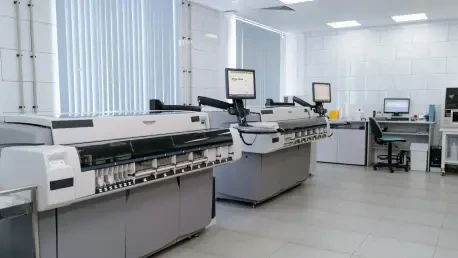In a world where technology evolves at an unprecedented pace, industrial ecosystems are undergoing a profound transformation driven by the seamless integration of digital tools, human ingenuity, and physical infrastructure, marking a significant shift in operational paradigms. This change is not merely about adopting new gadgets or software; it represents a fundamental reimagining of how industries operate, collaborate, and create value in a hyper-connected environment. From smart cities optimizing urban life to agricultural systems leveraging data for sustainability, the convergence of diverse elements into cohesive platforms is redefining what progress looks like. This dynamic interplay is setting the stage for sustainable growth and resilience, challenging traditional boundaries and fostering synergies across sectors. As industries navigate this complex landscape, the focus on interconnected systems offers a pathway to address global challenges with innovative, scalable solutions.
The Rise of Ecosystemic Thinking in Industry
Redefining Boundaries Through Collaboration
The concept of industrial ecosystems draws inspiration from biological systems, where interconnected components work together to create a thriving whole that surpasses the sum of its parts. This approach marks a departure from isolated, vertical strategies toward platform-based models that integrate technologies, stakeholders, and processes into a unified continuum. In regions like Italy, this mirrors historical manufacturing districts where collaboration between companies, research hubs, and local communities fueled economic success. Today, the challenge lies in adapting this collaborative spirit to the digital age, harnessing tools like artificial intelligence (AI), cloud computing, and the Internet of Things (IoT) to build systems that are both innovative and inclusive. Such ecosystemic thinking prioritizes not just technological advancement but also the alignment of human capital and governance structures to ensure lasting impact across industries.
Breaking Down Silos for Greater Impact
A critical aspect of ecosystemic thinking is the dismantling of silos that have long hindered industrial progress. By fostering synergies among diverse entities—be it businesses, public institutions, or technology providers—these platforms enable mutual reinforcement of skills, data, and infrastructure. This interconnectedness is evident in global trends where digital transformation thrives on shared networks rather than standalone innovations. For instance, European policies are increasingly focused on building collaborative frameworks that go beyond funding technology to nurture partnerships across sectors. In Italy, this translates into leveraging the nation’s creative human capital as a competitive advantage while addressing infrastructural gaps compared to more advanced nations. The result is a strategic shift toward systems that prioritize adaptability and resilience, ensuring industries remain competitive in a rapidly changing digital landscape.
Digital Tools and Human Elements in Harmony
Economic Potential of IoT and Beyond
The economic promise of digital technologies within industrial ecosystems is staggering, with IoT alone projected to generate between $5.5 trillion and $12.6 trillion in value by 2030, according to McKinsey estimates. This figure encapsulates not only infrastructure investments but also the tangible benefits delivered to consumers and businesses through enhanced efficiency and innovation. In Italy, the IoT market has shown robust growth, reaching a value of 9.7 billion euros in recent data, with an average of 2.6 connected devices per person, as reported by specialized observatories. This expansion reflects a broader trend where digital tools like sensors, data analytics, and satellite networks are integrated into physical environments, creating smarter, more responsive systems. The economic ripple effects of such technologies underscore their role as catalysts for industrial transformation on a global scale.
Balancing Technology with Human Capital
While digital tools drive much of the transformation within industrial ecosystems, the human element remains irreplaceable in ensuring sustainable outcomes. Smart cities serve as a prime example, where IoT systems and data analytics must align with institutional decisions and individual behaviors to create meaningful change. The challenge lies in harmonizing cutting-edge technologies with the creativity and adaptability of human resources, particularly in regions like Italy where historical strengths in innovation can be a unique asset. Beyond technical implementation, this balance requires robust governance and policies that support collaboration across public and private spheres. By placing people at the center of digital strategies, industries can build ecosystems that are not only technologically advanced but also socially impactful, paving the way for enduring progress in an interconnected world.
Case Study: A Model of Integrated Solutions
A compelling illustration of this harmony is seen in platforms that combine technology, consulting, and training to deliver comprehensive solutions across sectors like healthcare, agriculture, and urban planning. Such platforms often feature specialized centers for research and innovation, alongside scalable models that prioritize customer-centric approaches. Advanced technologies—including AI, blockchain, and automation—are embedded into processes through modern methodologies, ensuring seamless integration. Covering diverse applications from smart cities to space technologies, these ecosystems position themselves as orchestrators rather than mere providers, balancing human, digital, and physical dimensions. This model demonstrates how industrial ecosystems can evolve into adaptable frameworks that address complex challenges while maintaining a focus on sustainability and user needs.
Reflecting on a Collaborative Legacy
Looking back, the journey of industrial ecosystems reveals a powerful shift toward interconnected, collaborative systems that reshape how industries approach innovation. The integration of digital tools with human and physical elements proves to be a cornerstone of sustainable progress, as evidenced by the economic potential of technologies like IoT and the practical success of integrated platforms. Moving forward, the emphasis should be on scaling these models through supportive policies and cross-sector partnerships that bridge infrastructural and technological gaps. Industries must continue to prioritize breaking down silos, ensuring that collaboration remains at the heart of future strategies. By investing in both cutting-edge tools and the human ingenuity that drives them, the industrial landscape can build on this legacy to tackle emerging global challenges with resilience and vision.









